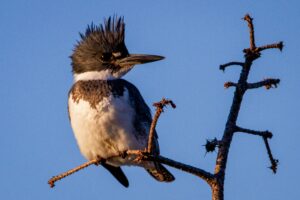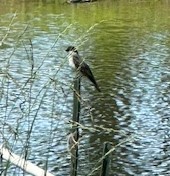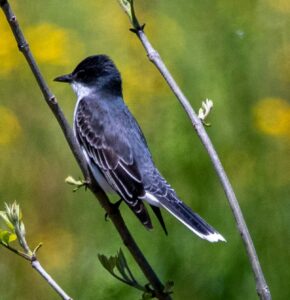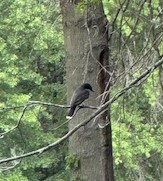The kings have finally been spotted – Kingfishers and Kingbirds!

We have Belted Kingfishers around the shore of our lake all year. These are good-sized birds whose call is a loud, prolonged rattle*, but it has been months since we last heard or saw one. We finally spotted one a week ago and the first time we saw it, it was right off our patio in the tall trees overlooking the inlet we share with our neighbor. And as usual, we found him because he rattled.

I am not sure where the two or three we often have around the lake nest – it would not be here. Kingfishers dig burrows into banks of softer earth. If you look at the photo to the right, you will see that they certainly have the sturdy beaks needed to use as digging tools. And these nests are often far from water. We do not have the necessary banks of softer earth right here at our small lake. Cleon and I have never seen juveniles, but throughout each year we have lived here, we have always seen a kingfisher at least a half a dozen times – always perched in trees along the shore of the lake or flying along the shore of the lake rattling away.

When we first moved here almost 20 year ago, we had Eastern Kingbirds every spring and summer. They would sit in the lower parts of trees and on top of the large shrubs all along our lake shore. We always had four or five every year. I do not mow very often as we do not have grass – we have what I call “plants under trees”. A mixture of some grasses with lots of perennial plants which I suppose others would call weeds (very few dandelions!). I love this mix because there is always something blooming somewhere. I mow about 3/4 of an acre and I have a riding mower, but I always mow with the blades at maximum height and at the slowest speed. And I mow around anything that looks interesting. The kingbirds loved this! They would perch in the trees closest to where I was mowing and grab anything that I flushed.

But, for the last several years, we have not seen any kingbirds and I do not know why. Not one has kept me company when I mowed. But they are back this year. We saw none this past spring, but they have been in and around our yard off and on since mid July.
This kingbird is a member of the Flycatcher Family. These are such interesting birds to watch as they perch. A trait of all members of this family is they move their heads in every direction – up, down, sideways, tilted one way, tilted the other. Always looking for  the next tasty thing flying by. I know of no other birds who move their heads so much when sitting still.
the next tasty thing flying by. I know of no other birds who move their heads so much when sitting still.
Cleon and I are glad to have both birds in our small wildlife refuge!
*To listen to recordings of the rattles of the Belted Kingfisher, a good website is allaboutbirds.org.

